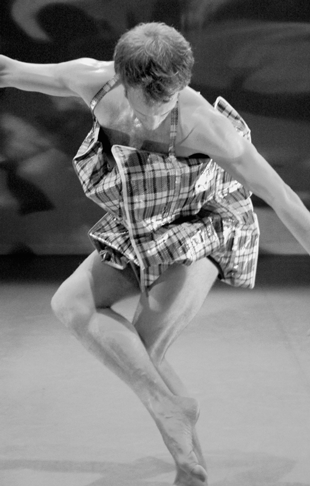Daniel Squire finds his choreographer’s voice
BY GUS SOLOMONS JR.
When you’re a member of Merce Cunningham’s company, you have caché in the dancer world, especially among aficionados of the avant-garde. You know you’re going to see dynamite technical dancing no matter what. So the debut of Daniel Squire’s four-dancer troupe Daniel Squire &c. this past weekend carried high expectation.
A native Brit, Squire joined Cunningham in 1998 and his go-for-broke energy and ruggedly handsome muscularity make him a standout onstage. Now he’s marking his territory as a dance maker.
The first part of his two-part “[sic]” inflects Cunningham’s linear, intensely technical vocabulary with Squire’s personal accent. The excitement of the piece is seeing how far the dancers can push their physical control. Squire is joined by two of his Cunningham colleagues—long-limbed, luscious Lisa Boudreau and coolly intense Rashaun Mitchell, who dances with riveting focus and technical sureness—and Tara Lorenzen, a little dare-devil who’s currently one of the Cunningham Repertory Understudy Group, the “RUGs,” and represents the incredible kinetic skills of the emerging crop of dancers.
On the rear curtain of the Cunningham studio theater a video fragment—by Squire—of a mallard duck about to take flight from the water’s surface loops continuously. Likewise, the dancers, perched on their toes much of the time, seem to be poised for flight. They move through Megan Byrne’s lustrous lighting, going from impossible balances on one leg with the torso tilted perilously, to impossible jumps that spin in midair and land solidly on one foot, to glacially slow leg extensions and deep, groin-stretching lunges, to lightning-fast direction shifts.
In section two of the two-part evening, percussionist Eli Fountain fills the air with richly evocative drumming, marimba and rain stick sounds. Still, the physical challenge of the movement and dancers’ unwavering concentration make this kinetic essay nearly as rigorous for us to watch as for the dancers to do. But in section one, set to songs by rock trio “deadbodies,” the dancing takes wing.
The rock pulse of the band—Beatles-reminiscent tunes with a hard back beat—and a cartoon-colorful video loop give the pelvis-thrusted slouches, high-heel walks, and leg-whipping hops from section one a buoyant, disco-tinged hipness. The dancers have changed from austere gray tights and light blue tank tops to plaid tote bags—fancifully devised by Jennifer Goggans into sack dresses—inflecting the new incarnations of the movement with delightful wackiness.
Squire skillfully rearranges his materials, giving familiar motifs fresh life in solo, duet, and trio groupings. Freed from the clinical precision of section one, in his solos, Squire’s raw energy and willful dynamic attack, knocking you out. Mastering the technical toughness and merciless precision of Cunningham’s lexicon has given all his amazing dancers virtually unlimited physical control. Squire exploits it with rigor and wit, finding a choreographer’s voice that’s far more than the echo of his master’s.
gaycitynews.com



































